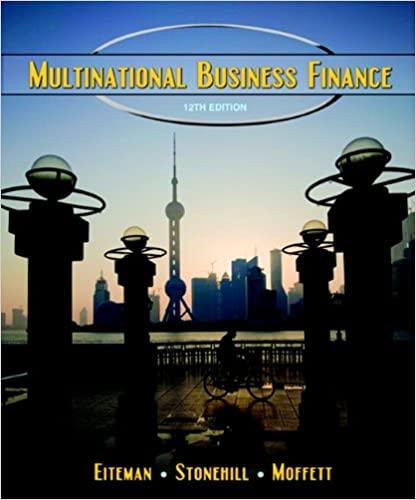Question
BUSINESS DECISION ANALYSIS WINTER 2021 FINAL CASE STUDY DR. TAHMINA AKHTER Cost-revenue-profit analysis Three production processes - A, B, and C - have the following
BUSINESS DECISION ANALYSIS WINTER 2021 FINAL CASE STUDY DR. TAHMINA AKHTER Cost-revenue-profit analysis Three production processes - A, B, and C - have the following cost structure: Process Fixed Cost per Year Variable Cost per Unit A $120,000 $3.00 B 90,000 4.00 C 80,000 4.50 a. What is the most economical process for a volume of 8,000 units? b. How many units per year must be sold with each process to have annual profits of $50,000 if the selling price is $6.95 per unit? c. What is the break-even volume for each process? Time Series Analysis and Forecasting Because of high tuition costs at state and private universities, enrollments at community colleges have increased dramatically in recent years. The following data show the enrollment (in thousands) for Jefferson Community College from 2001 to 2009. a. Construct a time series plot. What type of pattern exists in the data? b. Use simple linear regression analysis to find the parameters for the line that minimizes MSE for this time series. c. What is the forecast for 2010? Linear Programming The Northwest Flower Company owns a greenhouse, which furnishes roses and carnations to florists in Oregon, Washington, and Idaho. The greenhouse can grow any combination of the two flowers. They sell the flowers in "bunches" with 25 blooms to a bunch. They have 10,000 square feet available for planting this year. Each bunch of roses takes about 4 square feet and each bunch of carnations about 5 square feet. Special fertilizer is required for flowers: roses need 5 pounds and carnations 2 pounds. The availability of the fertilizer is limited to 5000 pounds. Sales commitments require the company to grow at least 500 bunches of roses. Profit contributions are $6 per bunch of roses and $8 per bunch of carnations. a. Formulate this problem as an LP. b. Graph this problem. c. What are the corner points of the feasible region? d. What is the optimal solution? Linear Programming: Sensitivity Analysis Investment Advisors, Inc., is a brokerage firm that manages stock portfolios for a number of clients. A particular portfolio consists of U shares of U.S. Oil and H shares of Huber Steel. The annual return for U.S. Oil is $3 per share and the annual return for Huber Steel is $5 per share. U.S. Oil sells for $25 per share and Huber Steel sells for $50 per share. The portfolio has $80,000 to be invested. The portfolio risk index (0.50 per share of U.S. Oil and 0.25 per share for Huber Steel) has a maximum of 700. In addition, the portfolio is limited to a maximum of 1000 shares of U.S. Oil. The linear programming formulation that will maximize the total annual return of the portfolio is as follows: The sensitivity report for this problem is shown in Figure 8.15. a. What is the optimal solution, and what is the value of the total annual return? b. Which constraints are binding? What is your interpretation of these constraints in terms of the problem? c. What are the shadow prices for the constraints? Interpret each. d. Would it be beneficial to increase the maximum amount invested in U.S. Oil? Why or why not? Integer Linear Programming Given the following all-integer linear program: Max 15x1 + 2x2 s. t. 7x1 + x2 < 23 3x1 - x2 < 5 x1, x2 > 0 and integer a. Solve the problem as an LP, ignoring the integer constraints. b. What solution is obtained by rounding up fractions greater than or equal to 1/2? Is this the optimal integer solution? c. What solution is obtained by rounding down all fractions? Is this the optimal integer solution? Explain. d. Show that the optimal objective function value for the ILP is lower than that for the optimal LP. e. Why is the optimal objective function value for the ILP problem always less than or equal to the corresponding LP's optimal objective function value? When would they be equal? Comment on the MILP's optimal objective function compared to the corresponding LP & ILP. Decision Analysis Southland Corporations decision to produce a new line of recreational products resulted in the need to construct either a small plant or a large plant. The best selection of plant size depends on how the marketplace reacts to the new product line. To conduct an analysis, marketing management has decided to view the possible long-run demand as low, medium, or high. The following payoff table shows the projected profit in millions of dollars: a. What is the decision to be made, and what is the chance event for Southlands problem? b. Construct an influence diagram. c. Construct a decision tree. d. Recommend a decision based on the use of the optimistic, conservative, and minimax regret approaches. Utility and Game theory In a certain state lottery, a lottery ticket costs $2. In terms of the decision to purchase or not to purchase a lottery ticket, suppose that the following payoff table applies: a. A realistic estimate of the chances of winning is 1 in 250,000. Use the expected value approach to recommend a decision. b. b. If a particular decision maker assigns an indifference probability of 0.000001 to the $0 payoff, would this individual purchase a lottery ticket? Use expected utility to justify your answer.
Step by Step Solution
There are 3 Steps involved in it
Step: 1

Get Instant Access to Expert-Tailored Solutions
See step-by-step solutions with expert insights and AI powered tools for academic success
Step: 2

Step: 3

Ace Your Homework with AI
Get the answers you need in no time with our AI-driven, step-by-step assistance
Get Started


